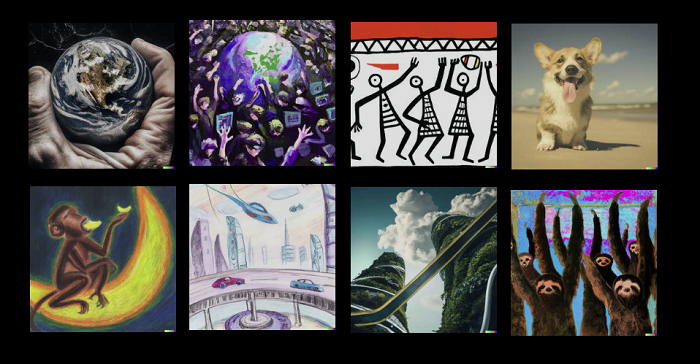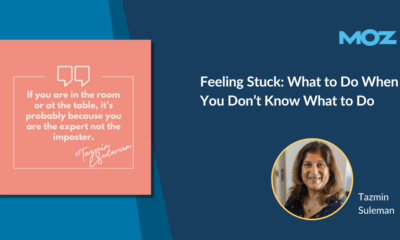SOCIAL
Can You Use AI-Generated Art in Your Digital Marketing and Content Efforts?

By now, you’ve likely tried out one of the new AI-based image generation tools, which ‘sample’ a range of image repository websites and online references to create all new visuals based on text prompts.
DALL·E is the most well-known of these new apps, while Midjourney has also become popular in recent months, enabling users to create some startling visual artworks, with virtually no effort at all.
But what are your usage rights to the visuals you create – and for marketers, can you actually use these images in your content, without potential copyright concerns?
Right now, it seems that you can – though there are some provisos to consider.
According to terms of use for DALL·E, users do have the rights to use their creations for any purpose, including commercial usage:
“Subject to your compliance with these terms and our Content Policy, you may use Generations for any legal purpose, including for commercial use. This means you may sell your rights to the Generations you create, incorporate them into works such as books, websites, and presentations, and otherwise commercialize them.”
Yes, you can even sell the visuals you create, though most stock photo platforms are now re-assessing whether they’ll actually accept such for sale.
This week, Getty Images became the latest platform to ban the upload and sale of illustrations generated through AI art tools, which, according to Getty, is due to:
“…concerns with respect to the copyright of outputs from these models and unaddressed rights issues with respect to the imagery, the image metadata and those individuals contained within the imagery.”
Part of the concern here is that the visuals that are used as the source material for these AI generated depictions may not be licensed for commercial use.
Though even that’s not necessarily a definitive legal barrier.
As explained by The Verge:
“Software like Stable Diffusion [another AI art tool] is trained on copyrighted images scraped from the web, including personal art blogs, news sites, and stock photo sites like Getty Images. The act of scraping is legal in the US, and it seems the output of the software is covered by “fair use” doctrine. But fair use provides weaker protection to commercial activity like selling pictures, and some artists whose work has been scraped and imitated by companies making AI image generators have called for new laws to regulate this domain.”
Indeed, various proposals have been put forward to potentially regulate and even restrict the use of these tools to protect artists, many of whom could well be out of the job as a result. But any such rules are not in place as yet, and it could take years before a legal consensus is established as to how to better protect artists whose work is sourced in the back-end.
There are even questions over the technical process of creation, and how that applies to legal protection in this sense. Back in February, the US Copyright Office effectively implied that AI-generated images can’t be copyrighted at all as an element of ‘human authorship’ is required.
In terms of specific content policies, DALL·E’s usage terms state that people cannot use the app to ‘create, upload, or share images that are not G-rated or that could cause harm’.
So no depictions of violence or hate symbols, while the DALL·E team also encourages users to proactively disclose AI involvement in their content.
DALL·E’s additional guidelines are:
- Do not upload images of people without their consent.
- Do not upload images to which you do not hold appropriate usage rights.
- Do not create images of public figures.
This is where further complications could come in. As noted by JumpStory, users of AI image generation tools should be wary of potential copyright concerns when looking to create images that include real people, as they may end up pulling in pictures of people’s actual faces.
JumpStory notes that many of the source images for the DALL·E project actually come from Flickr, and are subject to Flickr’s terms of use. For most generated depictions, like landscapes and artworks, etc., that’s not a problem, but it is possible that one of these tools could end up using a person’s real face, while re-creations of public figures could also be subject to defamation and misrepresentation, dependent on context.
Again, the legal specifics here are complex, and really, there’s no true precedent to go on, so how such a case might actually be prosecuted is unclear. But if you are looking to generate images of people, there may be complications, if that visual ends up directly resembling an actual person.
Clearly stating that the image is AI-generated will, in most cases, provide some level of clarity. But as a precautionary measure, avoiding clear depictions of people’s faces in your created images could be a safer bet.
MidJourney’s terms also make it clear violations of intellectual property are not acceptable:
“If you knowingly infringe someone else’s intellectual property, and that costs us money, we’re going to come find you and collect that money from you. We might also do other stuff, like try to get a court to make you pay our attorney’s fees. Don’t do it.”
Oddly tough talk for legal documentation, but the impetus is clear – while you can use these tools to create art, creating clearly derivative or IP infringing images could be problematic. User discretion, in this sense, is advised.
But really, that’s where things stand, from a legal perspective – while these systems take elements from other visuals online, the actual image that you’ve created has never existed till you created it, and is therefore not subject to copyright because your prompt is, in effect, the original source.
At some stage, the legal technicalities around such may change – and I do suspect, at some time, somebody will hold an AI art show or similar, or sell a collection of AI-generated art online which depicts significant elements of other artists’ work, and that will spark a new legal debate over what constitutes intellectual property violation in this respect.
But right now, full use of the images created in these tools is largely fine, as per the terms stated in the documentation of the tools themselves.
Note: This is not legal advice, and it’s worth checking with your own legal team to clarify your company’s stance on such before going ahead.
SOCIAL
Snapchat Explores New Messaging Retention Feature: A Game-Changer or Risky Move?

In a recent announcement, Snapchat revealed a groundbreaking update that challenges its traditional design ethos. The platform is experimenting with an option that allows users to defy the 24-hour auto-delete rule, a feature synonymous with Snapchat’s ephemeral messaging model.
The proposed change aims to introduce a “Never delete” option in messaging retention settings, aligning Snapchat more closely with conventional messaging apps. While this move may blur Snapchat’s distinctive selling point, Snap appears convinced of its necessity.
According to Snap, the decision stems from user feedback and a commitment to innovation based on user needs. The company aims to provide greater flexibility and control over conversations, catering to the preferences of its community.
Currently undergoing trials in select markets, the new feature empowers users to adjust retention settings on a conversation-by-conversation basis. Flexibility remains paramount, with participants able to modify settings within chats and receive in-chat notifications to ensure transparency.
Snapchat underscores that the default auto-delete feature will persist, reinforcing its design philosophy centered on ephemerality. However, with the app gaining traction as a primary messaging platform, the option offers users a means to preserve longer chat histories.
The update marks a pivotal moment for Snapchat, renowned for its disappearing message premise, especially popular among younger demographics. Retaining this focus has been pivotal to Snapchat’s identity, but the shift suggests a broader strategy aimed at diversifying its user base.
This strategy may appeal particularly to older demographics, potentially extending Snapchat’s relevance as users age. By emulating features of conventional messaging platforms, Snapchat seeks to enhance its appeal and broaden its reach.
Yet, the introduction of message retention poses questions about Snapchat’s uniqueness. While addressing user demands, the risk of diluting Snapchat’s distinctiveness looms large.
As Snapchat ventures into uncharted territory, the outcome of this experiment remains uncertain. Will message retention propel Snapchat to new heights, or will it compromise the platform’s uniqueness?
Only time will tell.
SOCIAL
Catering to specific audience boosts your business, says accountant turned coach

While it is tempting to try to appeal to a broad audience, the founder of alcohol-free coaching service Just the Tonic, Sandra Parker, believes the best thing you can do for your business is focus on your niche. Here’s how she did just that.
When running a business, reaching out to as many clients as possible can be tempting. But it also risks making your marketing “too generic,” warns Sandra Parker, the founder of Just The Tonic Coaching.
“From the very start of my business, I knew exactly who I could help and who I couldn’t,” Parker told My Biggest Lessons.
Parker struggled with alcohol dependence as a young professional. Today, her business targets high-achieving individuals who face challenges similar to those she had early in her career.
“I understand their frustrations, I understand their fears, and I understand their coping mechanisms and the stories they’re telling themselves,” Parker said. “Because of that, I’m able to market very effectively, to speak in a language that they understand, and am able to reach them.”Â
“I believe that it’s really important that you know exactly who your customer or your client is, and you target them, and you resist the temptation to make your marketing too generic to try and reach everyone,” she explained.
“If you speak specifically to your target clients, you will reach them, and I believe that’s the way that you’re going to be more successful.
Watch the video for more of Sandra Parker’s biggest lessons.
SOCIAL
Instagram Tests Live-Stream Games to Enhance Engagement

Instagram’s testing out some new options to help spice up your live-streams in the app, with some live broadcasters now able to select a game that they can play with viewers in-stream.
As you can see in these example screens, posted by Ahmed Ghanem, some creators now have the option to play either “This or That”, a question and answer prompt that you can share with your viewers, or “Trivia”, to generate more engagement within your IG live-streams.
That could be a simple way to spark more conversation and interaction, which could then lead into further engagement opportunities from your live audience.
Meta’s been exploring more ways to make live-streaming a bigger consideration for IG creators, with a view to live-streams potentially catching on with more users.
That includes the gradual expansion of its “Stars” live-stream donation program, giving more creators in more regions a means to accept donations from live-stream viewers, while back in December, Instagram also added some new options to make it easier to go live using third-party tools via desktop PCs.
Live streaming has been a major shift in China, where shopping live-streams, in particular, have led to massive opportunities for streaming platforms. They haven’t caught on in the same way in Western regions, but as TikTok and YouTube look to push live-stream adoption, there is still a chance that they will become a much bigger element in future.
Which is why IG is also trying to stay in touch, and add more ways for its creators to engage via streams. Live-stream games is another element within this, which could make this a better community-building, and potentially sales-driving option.
We’ve asked Instagram for more information on this test, and we’ll update this post if/when we hear back.
-

 WORDPRESS7 days ago
WORDPRESS7 days ago10 WordPress Influencers to Follow in 2024 – WordPress.com News
-

 SEARCHENGINES7 days ago
SEARCHENGINES7 days agoGoogle Image Search Adds Pixel Level Object Segmentation Animation
-

 MARKETING7 days ago
MARKETING7 days agoFeeling Stuck: What to Do When You Don’t Know What to Do
-

 PPC5 days ago
PPC5 days agoA History of Google AdWords and Google Ads: Revolutionizing Digital Advertising & Marketing Since 2000
-

 SEARCHENGINES6 days ago
SEARCHENGINES6 days agoMore Google March 2024 Core Update Ranking Volatility
-

 PPC6 days ago
PPC6 days agoCompetitor Monitoring: 7 ways to keep watch on the competition
-

 WORDPRESS6 days ago
WORDPRESS6 days agoThrive Architect vs Divi vs Elementor
-

 PPC6 days ago
PPC6 days ago31 Ready-to-Go Mother’s Day Messages for Social Media, Email, & More












You must be logged in to post a comment Login